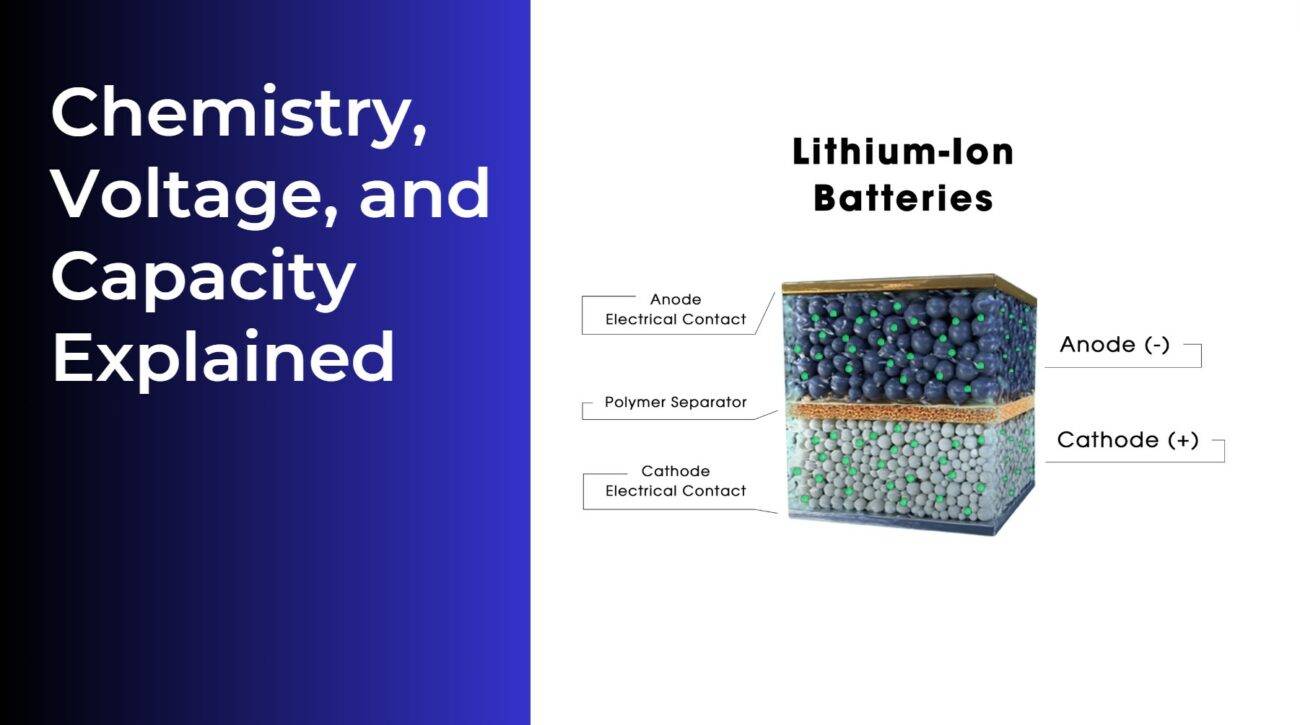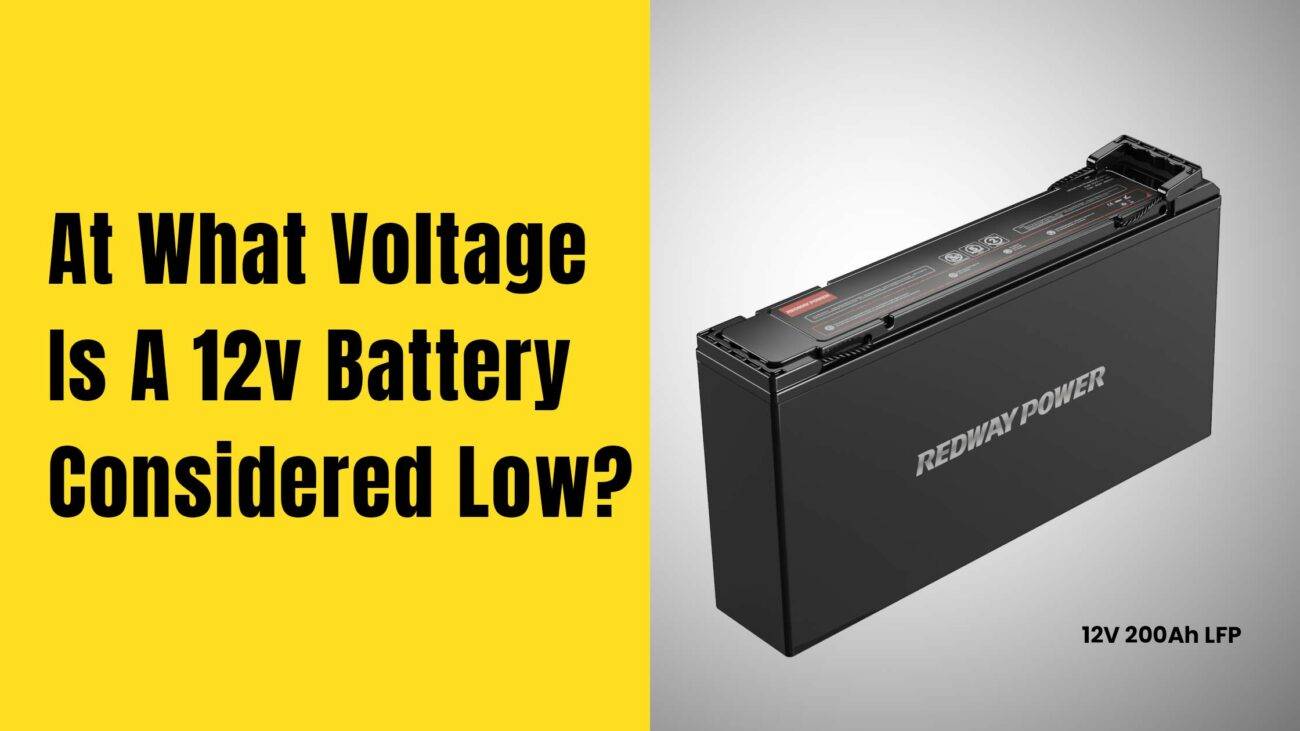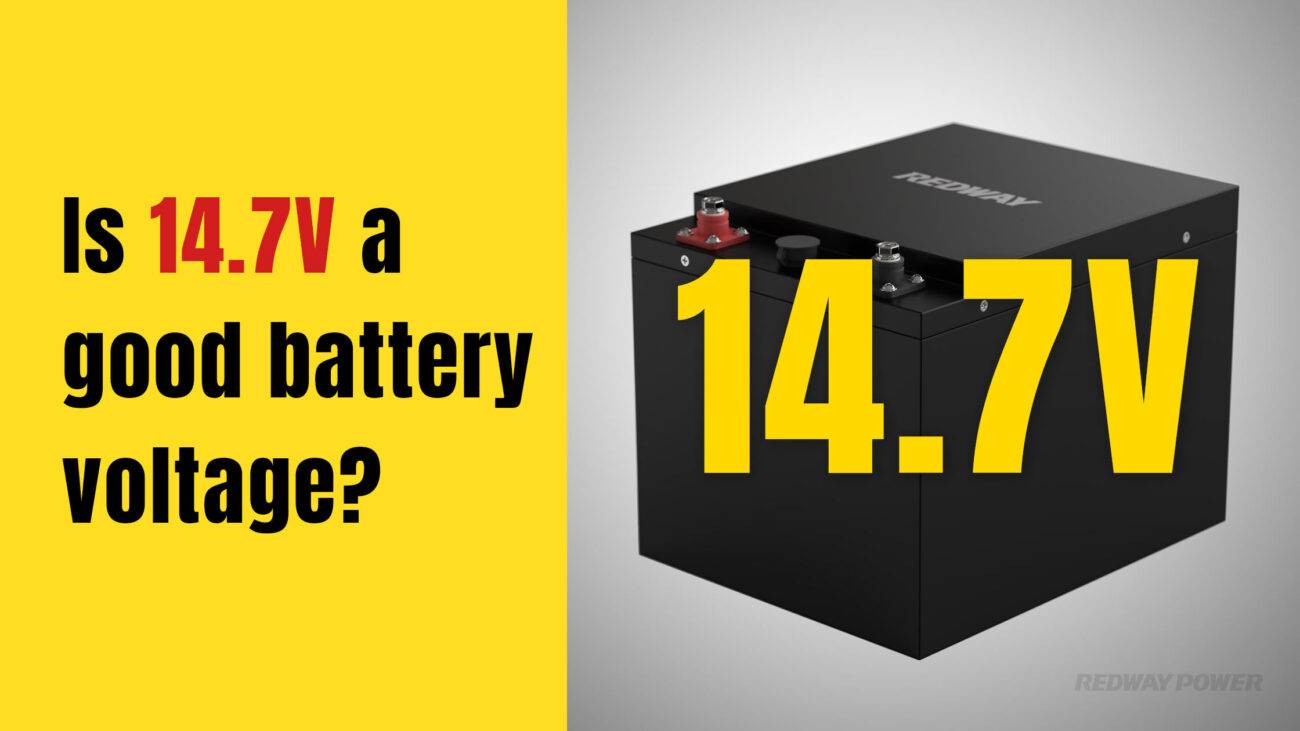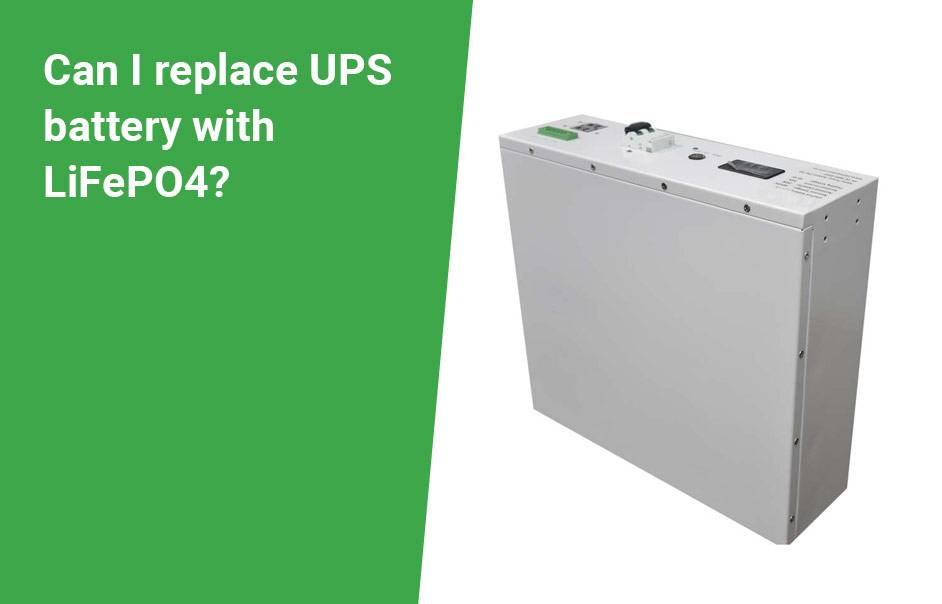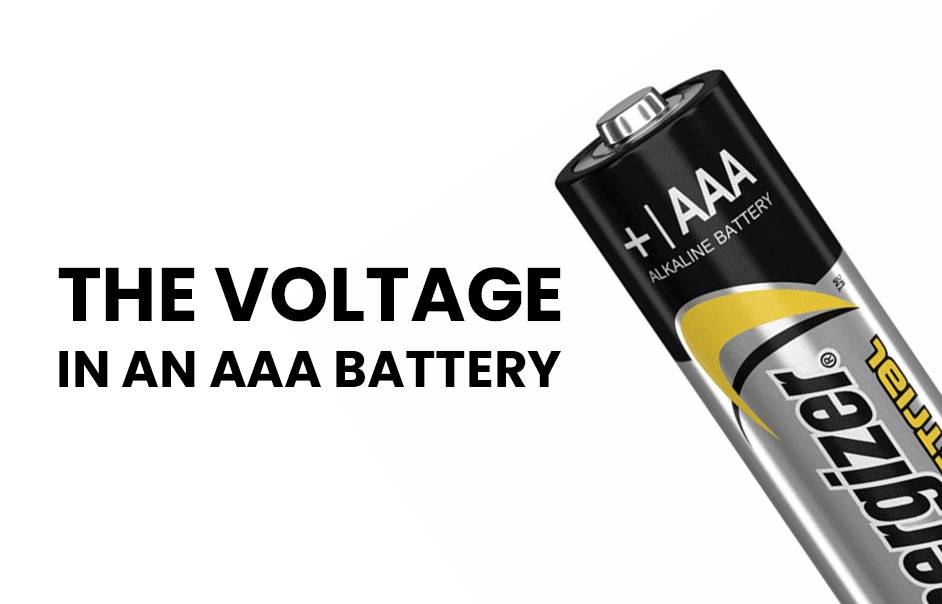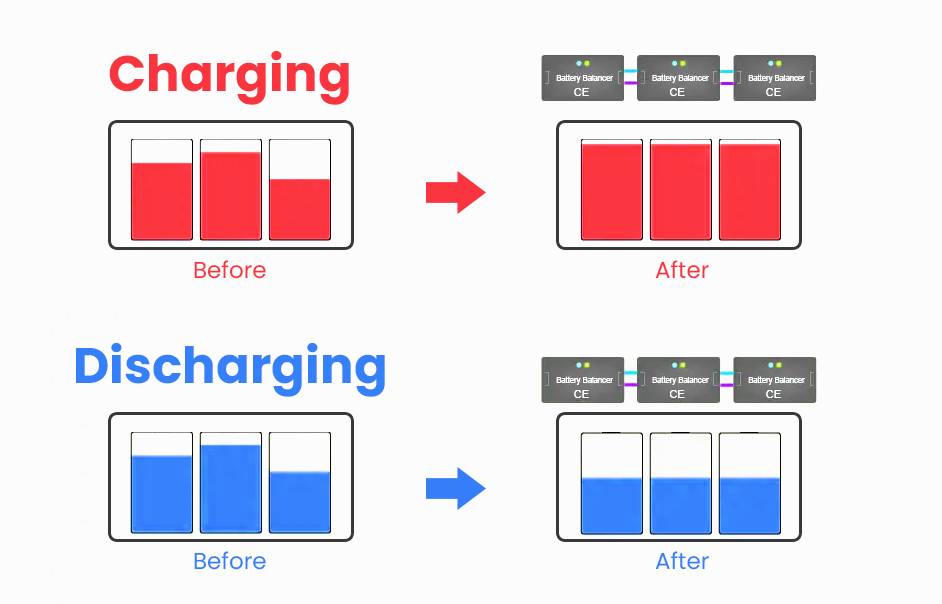- Rack-mounted Lithium Battery
- Golf Cart Lithium Battery
-
Golf Cart Lithium Battery
- 36V 50Ah (for Golf Carts)
- 36V 80Ah (for Golf Carts)
- 36V 100Ah (for Golf Carts)
- 48V 50Ah (for Golf Carts)
- 48V 100Ah (Discharge 100A for Golf Carts)
- 48V 100Ah (Discharge 150A for Golf Carts)
- 48V 100Ah (Discharge 200A for Golf Carts)
- 48V 120Ah (for Golf Carts)
- 48V 150Ah (for Golf Carts)
- 48V 160Ah (Discharge 100A for Golf Carts)
- 48V 160Ah (Discharge 160A for Golf Carts)
-
Golf Cart Lithium Battery
- Forklift Lithium Battery
- 12V Lithium Battery
- 24V Lithium Battery
- 36V Lithium Battery
- 48V Lithium Battery
-
48V LiFePO4 Battery
- 48V 50Ah
- 48V 50Ah (for Golf Carts)
- 48V 60Ah (8D)
- 48V 100Ah (8D)
- 48V 100Ah
- 48V 100Ah (Discharge 100A for Golf Carts)
- 48V 100Ah (Discharge 150A for Golf Carts)
- 48V 100Ah (Discharge 200A for Golf Carts)
- 48V 150Ah (for Golf Carts)
- 48V 160Ah (Discharge 100A for Golf Carts)
- 48V 160Ah (Discharge 160A for Golf Carts)
-
48V LiFePO4 Battery
- 60V Lithium Battery
-
60V LiFePO4 Battery
- 60V 20Ah
- 60V 30Ah
- 60V 50Ah
- 60V 50Ah (Small Size / Side Terminal)
- 60V 100Ah (for Electric Motocycle, Electric Scooter, LSV, AGV)
- 60V 100Ah (for Forklift, AGV, Electric Scooter, Sweeper)
- 60V 150Ah (E-Motocycle / E-Scooter / E-Tricycle / Tour LSV)
- 60V 200Ah (for Forklift, AGV, Electric Scooter, Sweeper)
-
60V LiFePO4 Battery
- 72V~96V Lithium Battery
- E-Bike Battery
- All-in-One Home-ESS
- Wall-mount Battery ESS
-
Home-ESS Lithium Battery PowerWall
- 24V 100Ah 2.4kWh PW24100-S PowerWall
- 48V 50Ah 2.4kWh PW4850-S PowerWall
- 48V 50Ah 2.56kWh PW5150-S PowerWall
- 48V 100Ah 5.12kWh PW51100-F PowerWall (IP65)
- 48V 100Ah 5.12kWh PW51100-S PowerWall
- 48V 100Ah 5.12kWh PW51100-H PowerWall
- 48V 200Ah 10kWh PW51200-H PowerWall
- 48V 300Ah 15kWh PW51300-H PowerWall
PowerWall 51.2V 100Ah LiFePO4 Lithium Battery
Highly popular in Asia and Eastern Europe.
CE Certification | Home-ESS -
Home-ESS Lithium Battery PowerWall
- Portable Power Stations
LiFePO4 Battery Voltage Chart (3.2V, 12V, 24V, 48V) Comparison
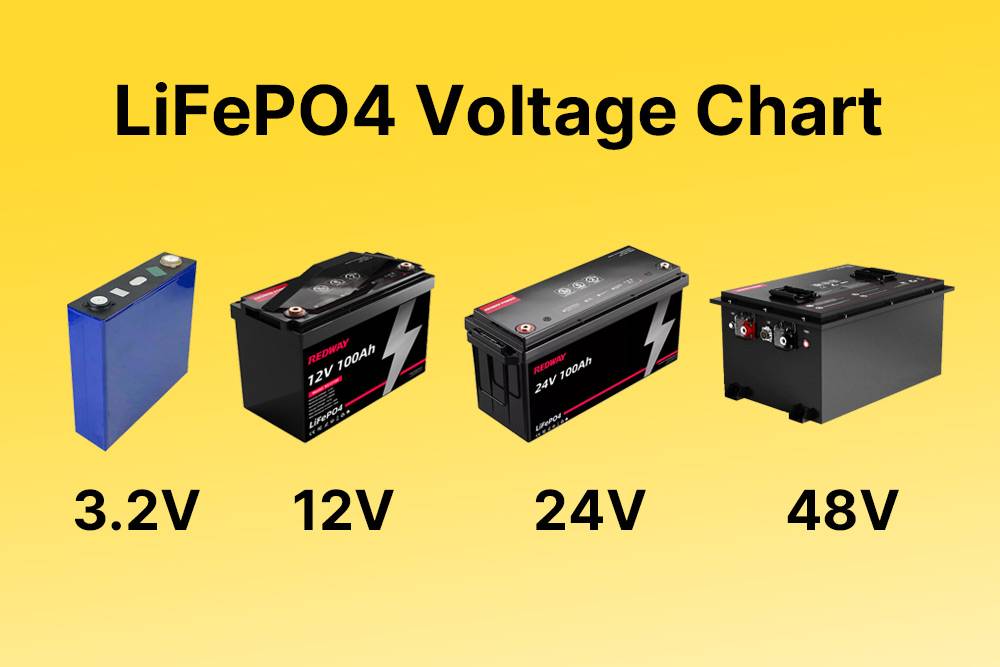
LiFePO4 batteries offer stable voltage across various configurations: 3.2V for single cells, 12V (four cells), 24V (eight cells), and 48V (sixteen cells). Applications vary from small electronics to electric vehicles. A comparison chart displays voltage levels for 12V and 24V configurations. Ideal for RVs, boats, scooters, and solar energy.
Being able to interpret the LiFePO4 voltage chart is essential for monitoring the battery’s performance and ensuring its safe operation.
What Is The Voltage Of A Lifepo4 Battery?
LiFePO4 batteries, known for safety and efficiency in solar systems, have a nominal voltage of 3.2 volts per cell. Their popularity stems from extended lifespan and high energy density. Voltage levels fluctuate with charging cycles, indicating energy storage capacity. Compared to traditional lithium-ion batteries, LiFePO4 offers enhanced safety and stability.
The voltage of LiFePO4 cells varies according to their state of charge. As the battery undergoes charging and discharging cycles, its voltage levels fluctuate. A higher LiFePO4 battery voltage signifies greater energy storage capacity, contributing to overall efficiency.
Detailed Voltage Chart
A detailed chart that compares the voltage levels of different battery types (e.g., LiFePO4, lead-acid, nickel-cadmium). Include columns for nominal voltage, fully charged voltage, and fully discharged voltage.
| Battery Type | Nominal Voltage | Fully Charged Voltage | Fully Discharged Voltage |
|---|---|---|---|
| LiFePO4 | 3.2V | 3.6V | 2.5V |
| Lead-Acid | 12V | 12.6V | 10.5V |
| Nickel-Cadmium | 1.2V | 1.4V | 1.0V |
In-Depth Battery Type Descriptions
LiFePO4 Batteries
- Chemistry and Construction: Lithium Iron Phosphate (LiFePO4) batteries utilize lithium iron phosphate as the cathode material and a carbon-based anode. They are known for their stable thermal properties and long life cycles.
- Common Applications: These batteries are widely used in electric vehicles, renewable energy systems, and stationary energy storage due to their high efficiency and safety.
- Advantages and Disadvantages:
- Advantages: Long lifespan, thermal stability, high safety, and good cycle performance.
- Disadvantages: Lower energy density compared to other lithium-ion chemistries.
Lead-Acid Batteries
- Chemistry and Construction: Lead-acid batteries consist of lead dioxide (PbO2) as the positive electrode and sponge lead (Pb) as the negative electrode, with sulfuric acid (H2SO4) serving as the electrolyte.
- Common Applications: They are primarily used in automotive applications for starting engines, backup power systems, and uninterruptible power supplies (UPS).
- Advantages and Disadvantages:
- Advantages: Low cost, high surge current capability, and easy recyclability.
- Disadvantages: Heaviness, limited cycle life, and environmental concerns due to lead toxicity.
Nickel-Cadmium Batteries
- Chemistry and Construction: Nickel-cadmium (NiCd) batteries use nickel oxide hydroxide as the cathode and cadmium as the anode, with a potassium hydroxide electrolyte.
- Common Applications: These batteries are often found in power tools, emergency lighting, and various consumer electronics.
- Advantages and Disadvantages:
- Advantages: Excellent performance under heavy discharge conditions, long cycle life, and reliability.
- Disadvantages: Memory effect leading to reduced capacity over time, environmental concerns due to cadmium’s toxicity.
This structured comparison provides a clear overview of different battery types, their voltage characteristics, and detailed descriptions of their chemistry, applications, advantages, and disadvantages.
What Does The Lifepo4 Voltage Chart Illustrate?
The LiFePO4 voltage chart displays voltage levels at different states of charge for various battery configurations (e.g., 12V, 24V, 48V). It visually represents how voltage changes during charging and discharging cycles, offering insights into energy storage capacity and performance. This aids in understanding LiFePO4 battery dynamics and optimizing their use.
| SOC | Single Cell | 12V | 24V | 48V |
| 100% Charging | 3.65V | 14.6V | 29.2V | 58.4V |
| 100% Rest | 3.40V | 13.6V | 27.2V | 54.4V |
| 90% | 3.35V | 13.4V | 26.8V | 53.6V |
| 80% | 3.32V | 13.3V | 26.6V | 53.1V |
| 70% | 3.30V | 13.2V | 26.4V | 52.8V |
| 60% | 3.27V | 13.1V | 26.1V | 52.3V |
| 50% | 3.26V | 13.0V | 26.1V | 52.2V |
| 40% | 3.25V | 13.0V | 26.0V | 52.0V |
| 30% | 3.22V | 12.9V | 25.8V | 51.5V |
| 20% | 3.20V | 12.8V | 25.6V | 51.2V |
| 10% | 3.00V | 12.0V | 24.0V | 48.0V |
| 0% | 2.50V | 10.0V | 20.0V | 40.0V |
Individual LiFePO4 cells commonly feature a nominal voltage of 3.2V. When fully charged, these cells reach a voltage of 3.65V, while when fully discharged, their voltage drops to 2.5V.
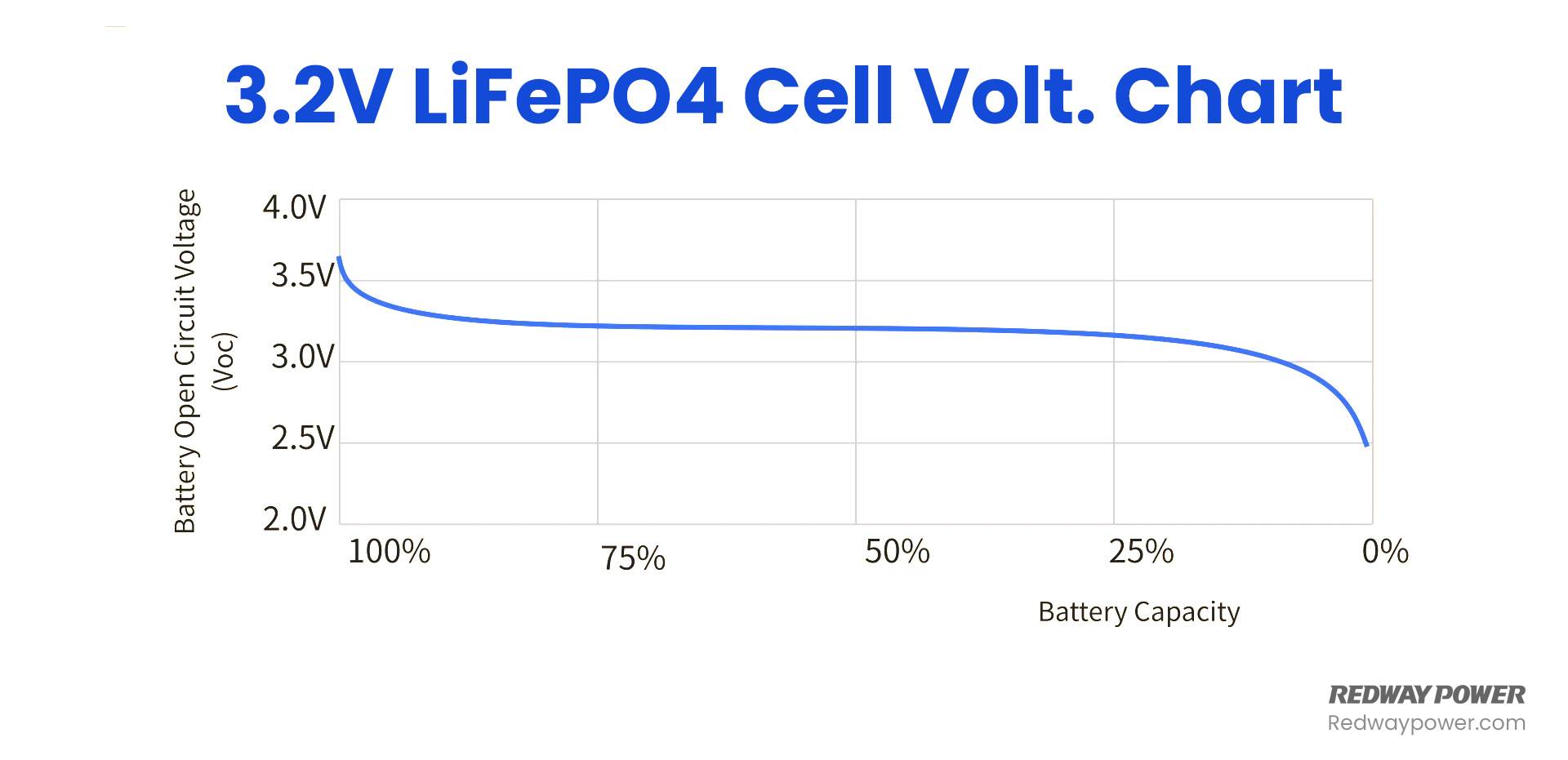
The 12V 100Ah LiFePO4 batteries serve as excellent replacements for 12V lead acid batteries, offering enhanced safety and performance, particularly in off-grid solar systems. When fully charged, these batteries reach a voltage of 14.6V, which gradually decreases as the battery discharges. At full discharge, the voltage drops to approximately 10V. The following 12V LiFePO4 battery voltage chart illustrates the relationship between voltage and battery capacity throughout the discharge cycle.
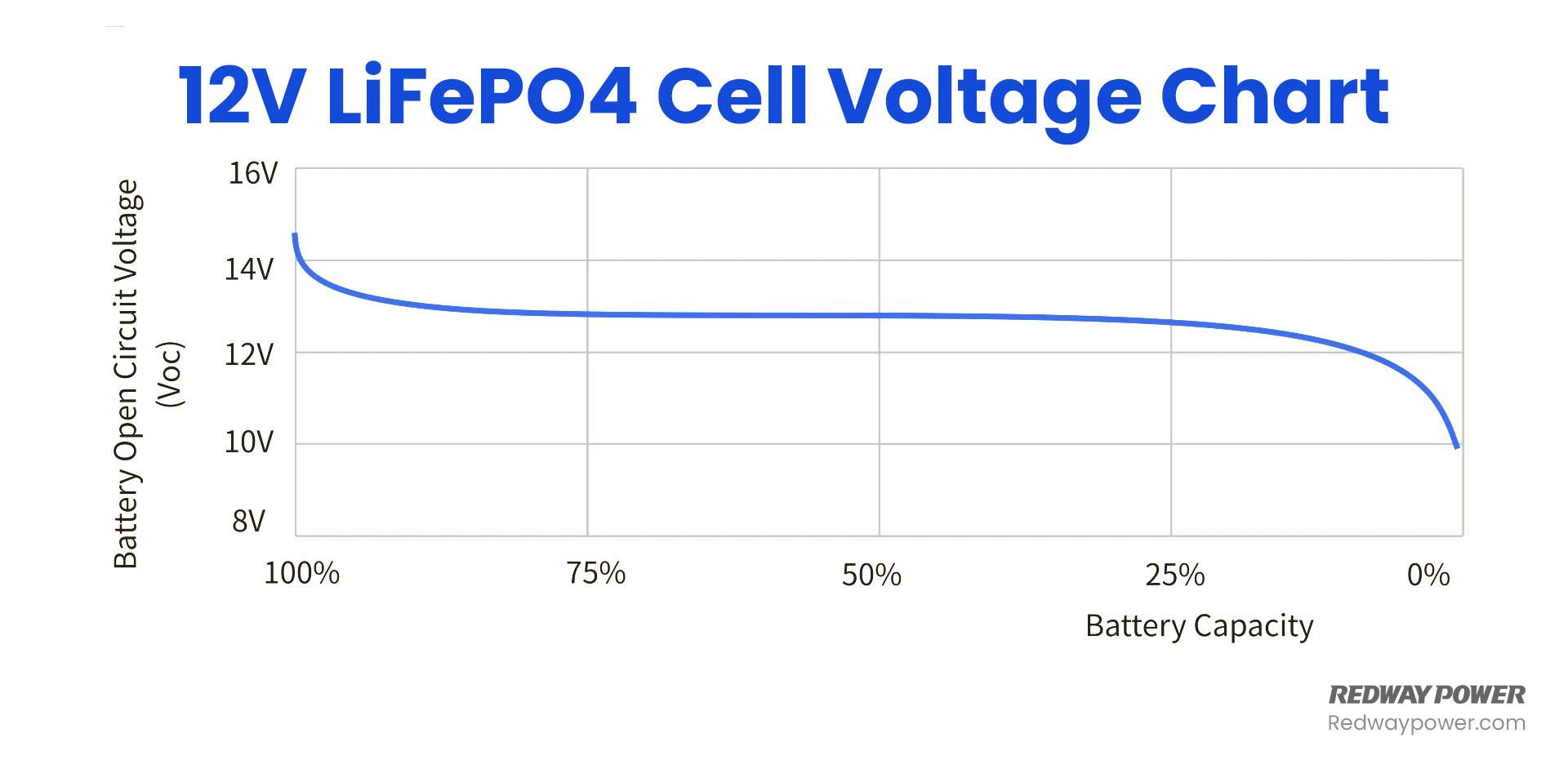
You have the option to either procure a 24V LiFePO4 battery or acquire two identical 12V LiFePO4 batteries and connect them in series. When fully charged, the voltage of these batteries reaches 29.2V, gradually decreasing as they discharge. At full discharge, the voltage drops to approximately 20V.
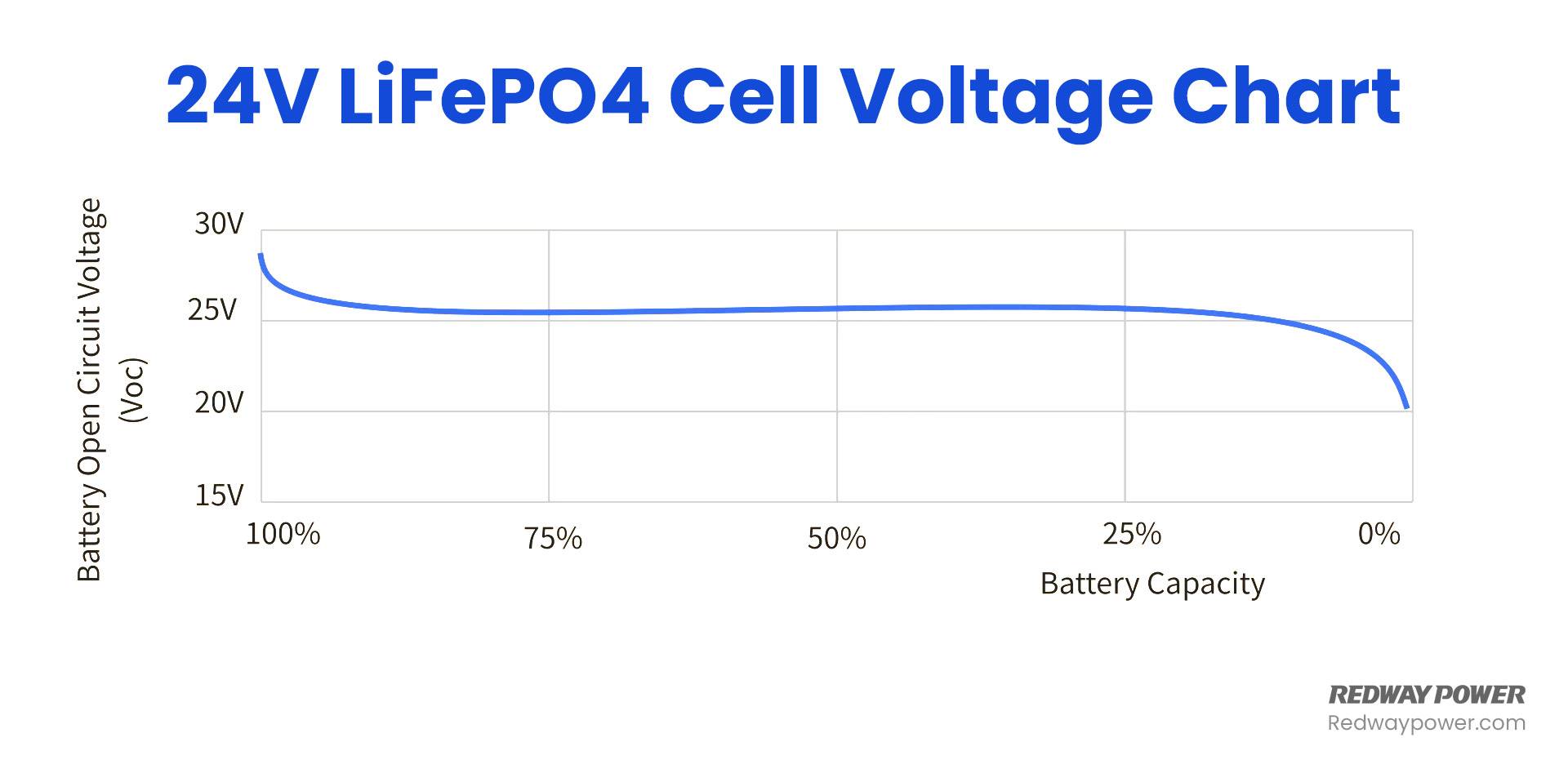
In larger solar power systems, 48V batteries are commonly utilized due to their capacity to handle higher voltages. These high-voltage systems effectively maintain low amperage levels, resulting in significant savings on equipment and wiring expenses.
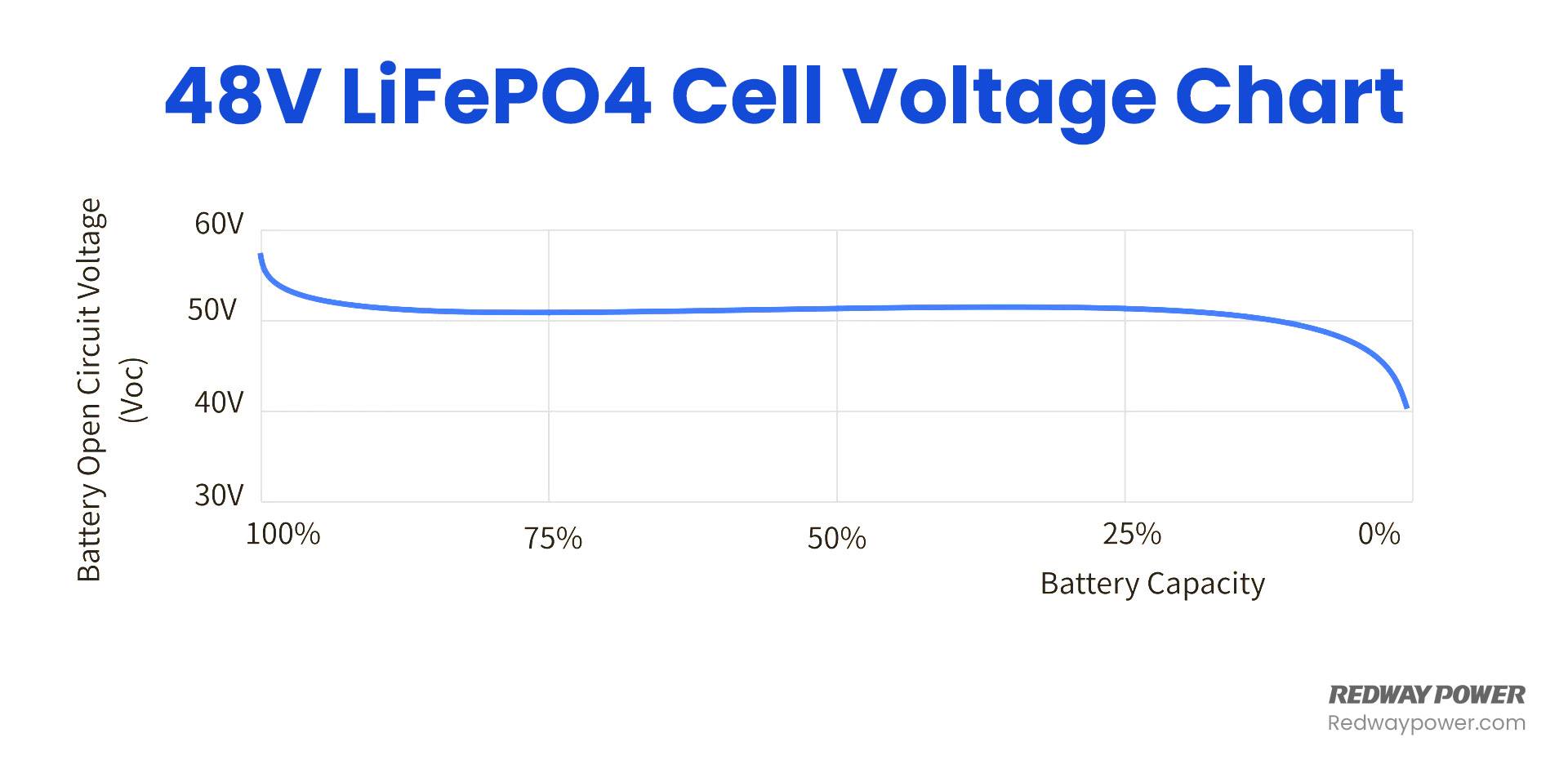
Charging And Discharging Of Lifepo4 Batteries
LiFePO4 battery charging involves monitoring state of charge (SoC) through voltage, typically ranging from 3.60V at 100% to 2.0V at 0%. Methods like voltage measurement and counting coulombs help assess SoC accurately. Proper charging extends battery lifespan; referencing SoC charts aids in optimal recharging. Voltage and SoC are intricately linked, crucial for understanding battery health and performance.
The following SoC and LiFePO4 battery voltage chart illustrates the correlation between these two parameters.
| SOC |
Voltage (V) |
| 100% | 3.60V~3.65V |
| 90% | 3.50V~3.55V |
| 80% | 3.45V~3.50V |
| 70% | 3.40V~3.45V |
| 60% | 3.35V~3.40V |
| 50% | 3.30V~3.35V |
| 40% | 3.25V~3.30V |
| 30% | 3.20V~3.25V |
| 20% | 3.10V~3.20V |
| 10% | 2.90V~3.0V |
| 0% | 2.0V~2.50V |
State of the Charge Curve
Determining a battery’s state of charge (SoC) can be achieved through various methods, each offering insights into the battery’s remaining capacity and health.
- Voltage: Battery voltage serves as a reliable indicator of SoC, with higher voltage levels indicating a fuller battery. For accurate readings, it’s essential to allow the battery to rest for at least four hours before measurement, or even up to 24 hours as recommended by some manufacturers.
- Counting Coulombs: This method involves measuring the current flowing in and out of the battery using ampere-seconds (As) to track the charging and discharging rate accurately.
- Specific Gravity: By employing a hydrometer to measure the liquid density based on buoyancy, this method offers insights into the SoC, particularly in lead-acid batteries.
To extend the lifespan of LiFePO4 batteries, it’s crucial to charge them properly, ensuring optimal performance and health. Each battery type has a specific voltage threshold that must be reached to achieve maximum performance while enhancing battery longevity. Utilizing the SoC chart as a reference during recharging can be beneficial. For instance, reaching 90% charge for a 24V battery would typically correspond to a voltage of around 26.8V.
The state of charge curve depicts how the voltage of a single-cell battery varies over time during the charging process, providing valuable information about the battery’s charging characteristics and behavior.
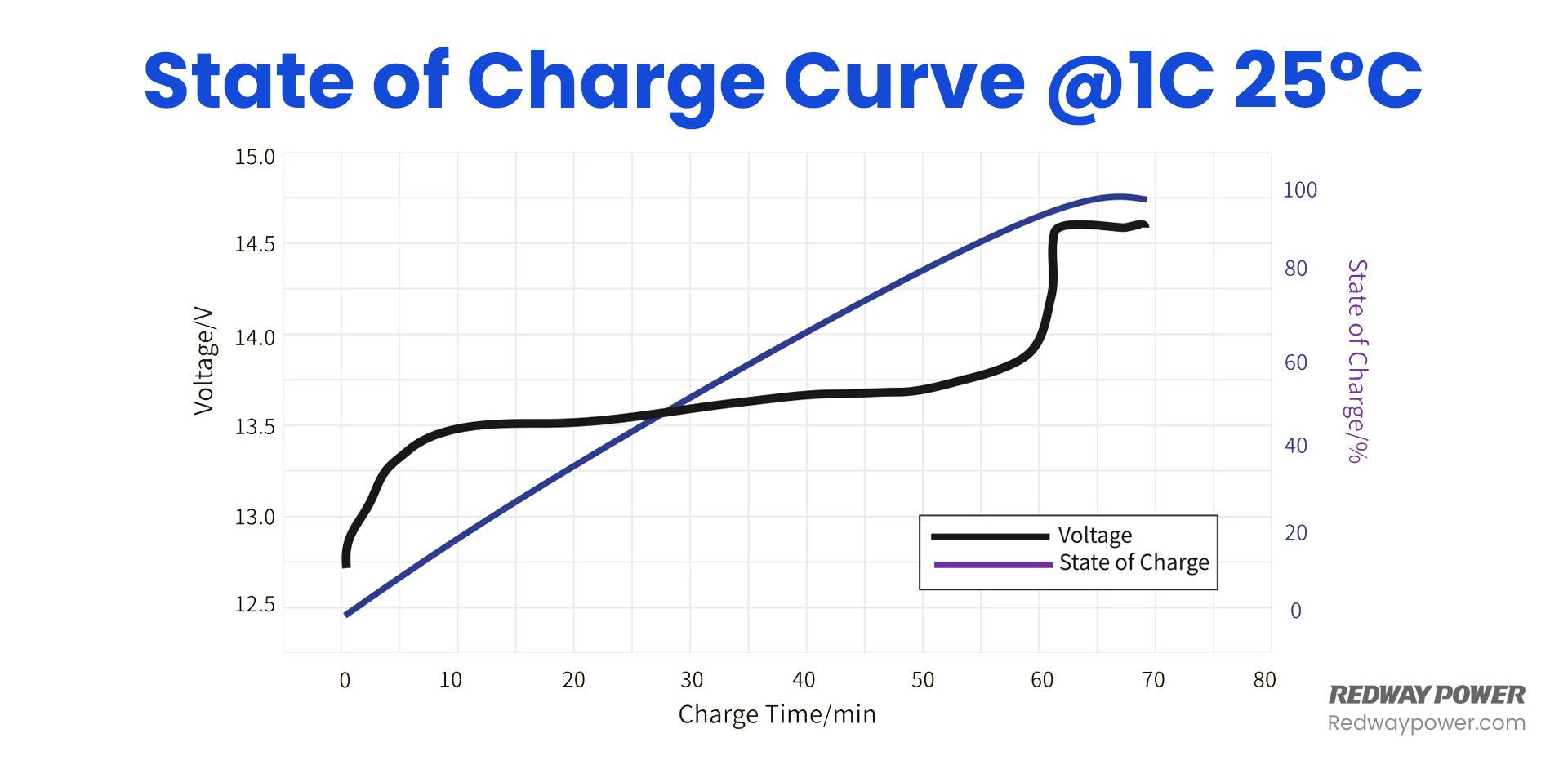
LiFePO4 Battery Charging Parameters
Basic LiFePO4 battery charging parameters encompass various voltage types, including charging, float, maximum/minimum, and nominal. The following table depicts these parameters at 3.2V, 12V, 24V, and 48V.
| Volt. |
3.2V | 12V | 24V | 48V |
| Charge Voltage | 3.5V ~ 3.65V | 14.2V ~ 14.6V | 28.4V ~ 29.2V | 56.8V ~ 58.4V |
| Float Voltage | 3.2V | 13.6V | 27.2V | 54.4V |
| Max. Voltage | 3.65V | 14.6V | 29.2V | 58.4V |
| Min.Voltage | 2.5V | 10V | 20V | 40V |
| Nominal Voltage | 3.2V | 12V/12.8V | 24V/25.6V | 48V/51.2V |
Float, Bulk, and Equalize Voltage of LiFePO4
It’s crucial to note that lithium batteries only support bulk charging, shutting off once fully charged.
The three primary types of voltages are bulk, float, and equalize:
Bulk Voltage: This is the voltage at which the battery charges rapidly, typically occurring during the initial charging phase when the battery is completely discharged. For a 12-volt LiFePO4 battery, the bulk voltage is 14.6V.
Float Voltage: Maintained at a level lower than the bulk voltage, float voltage sustains once the battery reaches full charge. For a 12-volt LiFePO4 battery, the float voltage is 13.5V.
Equalize Voltage: Equalization is a vital process for maintaining battery capacity, and it’s recommended to be conducted regularly. The equalize voltage for a 12-volt LiFePO4 battery is 14.6V.
| Types | 3.2V | 12V | 24V | 48V |
| Bulk | 3.65V | 14.6V | 29.2V | 58.4V |
| Float | 3.375V | 13.5V | 27.0V | 54.0V |
| Equalize | 3.65V | 14.6V | 29.2V | 58.4V |
Battery Discharge Curve
Discharging involves withdrawing power from the battery to charge appliances. The battery discharge chart typically illustrates the correlation between voltage and discharge time.
Here’s the discharge curve for 12V LiFePO4 batteries at various discharge rates.
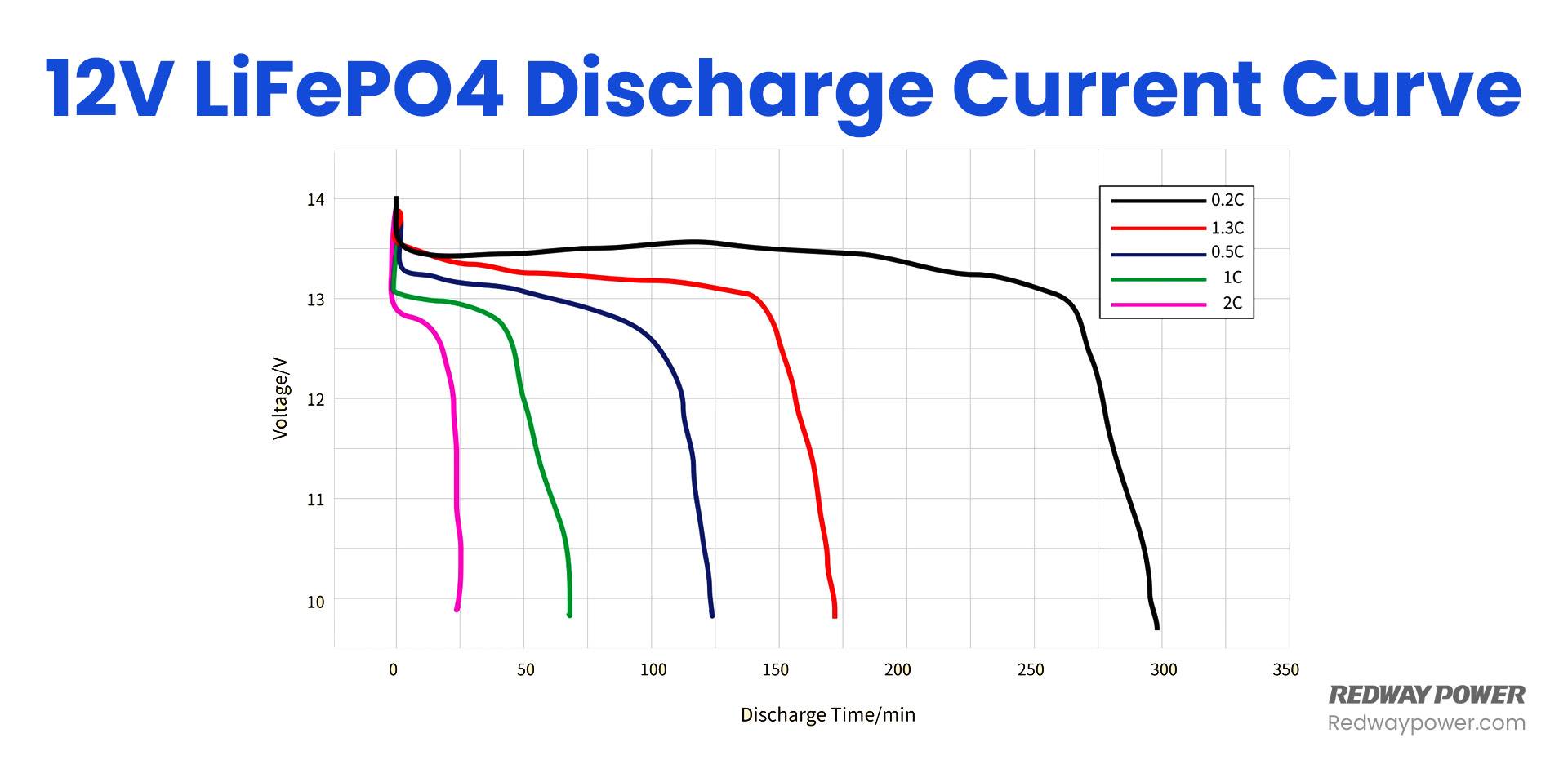
Extending the lifespan of a battery hinges significantly on understanding its Depth of Discharge (DoD), representing the discharged battery capacity relative to its total capacity. Essentially, the more a LiFePO4 battery undergoes charging and discharging cycles, the shorter its lifespan becomes.
Discharge is often depicted through charts and curves, with DoD serving as a crucial metric to assess the fraction of power withdrawn from a battery. Battery discharge occurs when the battery fully depletes its charge.
Below is a table showcasing batteries with varying Ah ratings and their maximum discharge currents across different time intervals.
| Battery or Battery Pack Ah Rating | 7 Minute Maximum Discharge Current | 30 Minute Maximum Discharge Current |
| 5Ah | 15 Amps | 10 Amps |
| 7Ah | 21 Amps | 14 Amps |
| 8Ah | 24 Amps | 16 Amps |
| 9Ah | 27 Amps | 18 Amps |
| 10Ah | 31 Amps | 21 Amps |
| 12Ah | 36 Amps | 24 Amps |
| 14Ah | 42 Amps | 31 Amps |
| 15Ah | 44 Amps | 32 Amps |
| 18Ah | 57 Amps | 40 Amps |
| 22Ah | 66 Amps | 46 Amps |
| 35Ah | 105 Amps | 84 Amps |
How Does Lifepo4 Battery Voltage Affect Performance?
LiFePO4 battery voltage significantly influences performance across capacity, charging, discharging, efficiency, and lifespan. Higher voltage correlates with increased capacity and efficiency, but requires optimal charging to prevent damage. Discharging below recommended voltage thresholds can diminish lifespan. Higher voltage batteries tend to have longer lifespans due to increased charge cycle endurance.
Capacity: Battery capacity and voltage exhibit a direct proportional relationship. Higher voltage results in increased battery capacity. Consequently, a 24V LiFePO4 battery offers greater capacity compared to a similarly sized 12V battery.
Charging: Optimal charging voltage and current are critical for LiFePO4 batteries’ performance. Inadequate charging voltage may lead to incomplete charging and reduced capacity, while excessively high voltage can cause overcharging, potentially damaging the battery.
Discharging: The discharge voltage of a LiFePO4 battery influences its performance. Discharging the battery below the recommended voltage threshold can result in irreversible damage and diminish its lifespan.
Efficiency: LiFePO4 battery efficiency correlates directly with voltage. Higher voltage batteries are more efficient in powering devices, making them a preferred choice for maximizing energy utilization.
Lifespan: LiFePO4 batteries with higher voltage tend to have longer lifespans compared to lower voltage counterparts. Higher voltage batteries can endure more charge cycles, enhancing their longevity.
Methods For Checking Lifepo4 Battery Capacity
Ensure LiFePO4 battery capacity with three methods: Multimeter Measurement—check open circuit voltage after disconnecting loads; Battery Monitor—connect a quality monitor for straightforward assessment; Solar Charge Controller—although less accurate due to connected loads. Monitoring capacity safeguards battery safety and longevity.
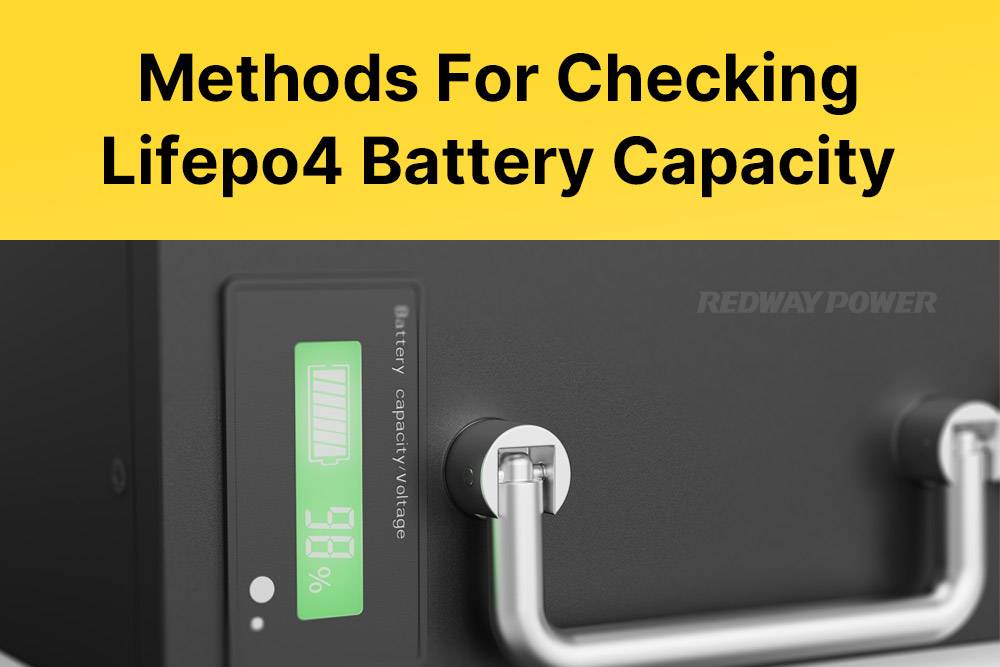
Method 1: Multimeter Measurement
Using a multimeter to check the open circuit battery voltage provides moderately accurate results. However, disconnecting all loads and chargers and allowing the battery to rest is necessary. After 15-30 minutes, measure the open circuit voltage and compare it with the battery’s state of charge (SoC) chart or voltage curve chart.
Method 2: Battery Monitor
Utilizing a battery monitor is a straightforward and reliable method to measure battery capacity. Simply connect a high-quality battery monitor to the battery and assess the charge level.
Method 3: Solar Charge Controller
While using a solar charge controller to determine battery capacity may seem convenient, it’s not the most accurate method. Voltage readings may be inaccurate due to measurements being taken with loads and chargers connected.
How to Increase The LiFePO4 Battery Lifespan?
To increase LiFePO4 battery lifespan: Maintain moderate temperatures, avoid rapid charging or discharging to prevent overheating, and keep Depth of Discharge (DoD) below 80% to avoid irreversible damage. These practices ensure optimal performance and longevity for LiFePO4 batteries, which can last up to a decade with proper care.
Several factors influence the lifespan of a 12V LiFePO4 battery:
Temperature: Maintaining the battery within a moderate temperature range is crucial for longevity and optimal performance. Extreme temperatures can negatively impact the battery’s lifespan.
Charging and Discharging Rates: Rapid charging or discharging can generate heat, potentially damaging the battery’s internal components. It’s advisable to charge and discharge the battery at recommended rates to prevent overheating and extend its lifespan.
Depth of Discharge (DoD): Over-discharging a LiFePO4 battery can lead to irreversible damage and reduce its lifespan. To maximize longevity, it’s recommended to keep the Depth of Discharge (DoD) below 80%, ensuring that the battery is not discharged beyond this threshold.
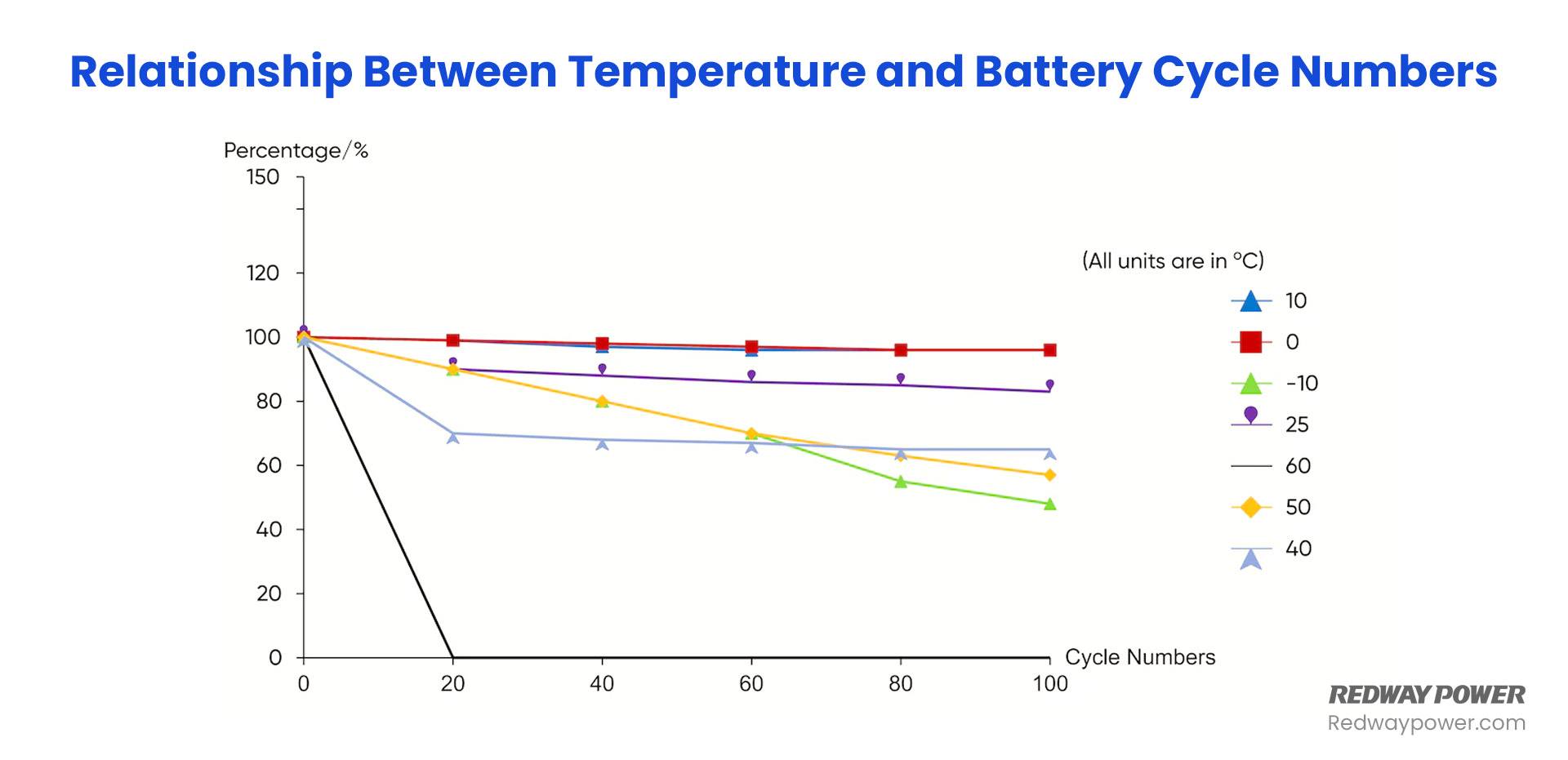
Increasing the battery’s Ah capacity is a straightforward method to enhance its lifespan and charging/discharging rates. Additionally, wrapping the cells with nylon tape and maintaining the battery at a cool temperature can further contribute to prolonging its lifespan. These measures help mitigate heat buildup and promote optimal performance, ultimately extending the battery’s longevity.
| Voltage | Capacity | Charge Cycles | Lifespan (Above 80% Original Capacity) |
| (V) | (Ah %) | (If charged and discharged to each of these voltages every day) | (Charged once a day) |
| 14.4V | 100% | 3200 cycles | 9 years |
| 13.6V | 100% | 3200 cycles | 9 years |
| 13.4V | 99% | 3200 cycles | 9 years |
| 13.3V | 90% | 4500 cycles | 12.5 years |
| 13.2V | 70% | 8000 cycles | 20 years |
| 13.1V | 40% | 8000 cycles | 20 years |
| 13.0V | 30% | 8000 cycles | 20 years |
| 12.9V | 20% | 8000 cycles | 20 years |
| 12.8V | 17% | 6000 cycles | 16.5 years |
| 12.5V | 14% | 4500 cycles | 12.5 years |
| 12.0V | 9% | 4500 cycles | 12.5 years |
| 10.0V | 0% | 3200 cycles | 9 years |
LiFePO4 Voltage Chart FAQs
What is the minimum voltage for potential damage in LiFePO4 batteries?
The minimum voltage threshold for potential damage in 12V LiFePO4 batteries is approximately 10V. Discharging the battery below this level can lead to permanent damage. It’s crucial to consult the LiFePO4 battery voltage chart and ensure safe charging practices.
What is the low voltage cutoff for LiFePO4 batteries?
The low voltage cutoff for LiFePO4 batteries represents the predetermined voltage threshold below which the battery should not discharge. Typically, this value is around 2.5V per cell.
What is the recommended bulk absorb voltage for LiFePO4 batteries?
The recommended bulk/absorb voltage range for LiFePO4 batteries typically falls between 14.2V and 14.6V. Some systems may allow for slightly higher voltages, up to around 14.8-15.0V, with careful consideration and monitoring before disconnecting the battery.
How can I identify if my LiFePO4 battery is defective?
While LiFePO4 batteries offer longevity, signs of degradation may appear over time. Here are a few indicators of a potentially defective LiFePO4 battery:
- Extended or failed charging processes, where the battery takes significantly longer to charge or fails to charge altogether.
- Unexpected power loss in electronic devices, even with a seemingly sufficient battery charge.
- Physical deformation, such as bulging or swelling of the battery casing, indicating potential internal damage or malfunction.
Final Thoughts
Even though LiFePO4 batteries are not the least expensive or budget-friendly, they are the most cost-effective in the long run. You can quickly check the battery’s SoC using the LiFePO4 voltage chart.
FAQs
Why is Battery Maintenance Important for Infrequently Used Vehicles?
What Happens When Lead-Acid Battery Voltage Drops Below 12.4 Volts?
Why is 12.4 Volts a Key Voltage Threshold for Batteries?
What Voltage Level is Fully-Charged for a 12-Volt Battery?
How do battery discharge rates vary based on the load connected to the battery?
Battery discharge rates increase with heavier loads. Higher current draws accelerate the discharge process, leading to faster voltage drop and reduced battery life.
What factors can affect the voltage curves of lead-acid batteries?
Temperature, discharge rate, age, and battery state of charge affect lead-acid battery voltage curves. High temperatures and fast discharge rates typically lower voltage, while age increases internal resistance and decreases performance.
Why are lithium iron phosphate (LiFePO4) batteries commonly used in solar systems?
LiFePO4 batteries are popular in solar systems due to their high energy density, long cycle life, safety, and thermal stability. They offer consistent performance and can handle deep discharges better than other battery types.
What are the voltage levels for a 12V flooded lead-acid battery at various states of charge?
- 100%: 12.7–12.8V
- 75%: 12.4V
- 50%: 12.2V
- 25%: 12.0V
- 0%: 11.8V
What are the voltage levels for a 12V AGM lead-acid battery at various states of charge?
- 100%: 12.7–12.8V
- 75%: 12.4V
- 50%: 12.2V
- 25%: 12.0V
- 0%: 11.8V
What are the voltage levels for a 6V AGM lead-acid battery at various states of charge?
- 100%: 6.4–6.6V
- 75%: 6.2V
- 50%: 6.0V
- 25%: 5.8V
- 0%: 5.6V
What are the voltage levels for a 6V flooded lead-acid battery at various states of charge?
- 100%: 6.3–6.4V
- 75%: 6.1V
- 50%: 5.9V
- 25%: 5.7V
- 0%: 5.5V
How does the maintenance of flooded lead-acid batteries compare to AGM lead-acid batteries?
Flooded lead-acid batteries require regular watering and venting, whereas AGM batteries are maintenance-free and sealed. AGM batteries are more convenient but typically cost more.
What are the different types of lead-acid batteries covered in the article?
The article covers flooded lead-acid, AGM (Absorbent Glass Mat), and Gel lead-acid batteries. Each type has distinct maintenance needs and performance characteristics.

















